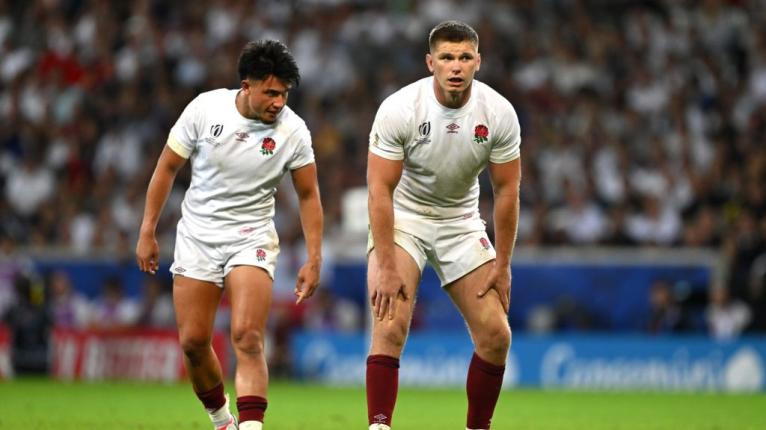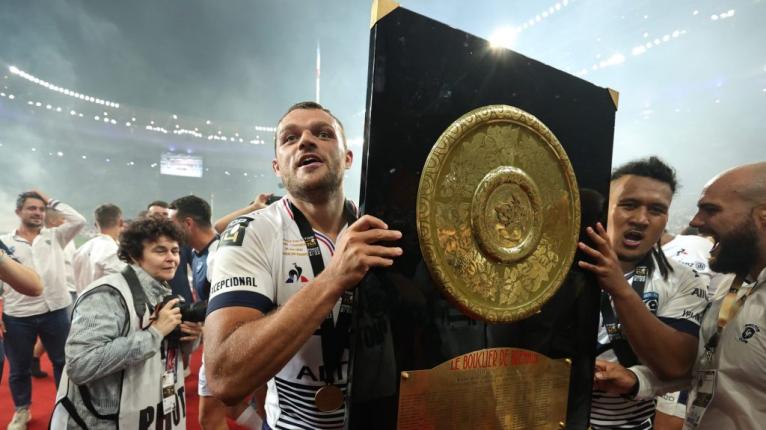Every key player needs actors around him who can help him produce his best performance. When Steve Borthwick and his coaching panel sit down to discuss their options at 10 for the Six Nations campaign, that thought will influence the choices they make in other spots, notably at inside centre and number eight.
One of the major problems for Marcus Smith during his first coming in an England jersey was his pairing with Owen Farrell at 12. The theory behind the partnership sounded good – stick an experienced head alongside the Quins magician to do most of the navigational work and nurse him along, and leave Smith to pull rabbits out of the hat.
Eddie Jones persisted with the idea for the better part of a year, but it never looked like working. In practice, Smith and Farrell simply trod on each other’s toes far too often, with Farrell’s dominant on-field personality taking the reins and Smith pushed to the margins. Smith may have rode in on a white donkey with confetti floating in the air, but when Borthwick replaced Jones, he departed the same way he arrived.
Some 10s enjoy working with an alternate playmaker alongside them at 12 or 15 – Farrell himself has often produced his best rugby with Saracens’ Alex Goode at full-back or in tandem with George Ford for England. Others prefer to know they will be the one calling the shots.

Smith falls into the latter category, and that is why Quins tend to surround him with pure power at 12, in the form of Andre ‘the Giant’ Esterhuizen, and a rapid counter-attacker from the back in Tyrone Green. As far as playmaking goes, Smith knows he is ‘the man’ and responds accordingly.
Borthwick’s choice at the back of the scrum will also be critical if he starts Smith. Although the two positions are not directly connected, Smith enjoys such a symbiotic attacking relationship with Alex Dombrandt at club level that the number eight is regularly winning awards for ‘Best Supporting Actor’ to the young prince himself.
If Harlequins are to provide the model, then finding the right synergy at 8, 10 and 12 will be central to England’s chances of success, and this is where the problems in selection begin. Dombrandt started the first six games of the Borthwick era, only to be omitted from the World Cup squad in favour of Billy Vunipola.
The Cumbrian explained the decision as follows: “There are always good players that are going to miss out on the squad. I think [Alex Dombrandt] is a very, very good player. There is a lot of competition in that back row. Lewis Ludlam’s ability to play in all three positions. Ben Earl [at] 7 and 8 and Tom Curry [at] 7, 8 – he played 6 at the last World Cup. It’s about making the decisions and having the right combinations.”
In the event, England advanced to the semi-final stage with a non-specialist [Earl] starting in the pivotal number 8 spot. Borthwick’s comments would also have raised some understandable questions in the mind of Zach Mercer, who had made a special effort to return to England from the Top 14 in time to compete for a World Cup spot. Mercer is the best 8/7 ‘tweener’ on the European circuit and had won the Top 14 player of the season award at the end of 2022, in a year when his club lifted the Bouclier de Brennus, but like Dombrandt he became a casualty of the selection process.

One of his coaches at Montpellier, Bruce Reihana, was in no doubt of his value: “I am very, very surprised and shocked Zach is not in the squad and the way he played when we won the league was phenomenal. Anyone who moves to France and wins player of the year is really something.
“I would have him starting at number 8 because he offers so much more than anyone else. His differences are huge compared to all the others, and I would compare his impact to what Kieran Read did for the All Blacks.
“That is the kind of player you need on the pitch because he has great offloading skills, he can run over you and he can beat you with his footwork. It is one thing to run straight at people but if you have that x-factor it makes such difference and he is the complete package.
“He proved that because he is also a line out jumper. When you go to a World Cup you need someone with that full package.”
Dombrandt and Mercer found themselves in direct opposition for their clubs at Twickenham last weekend. If it was not already an audition for the same role on a national stage, then it probably deserved to be. Mercer’s talents have hardly been showcased by Gloucester’s current travails [they lie 9th with only winless Newcastle below them in the table], but he still finished the game with the most carries and tackles by any forward on either side – 18 runs for 76m with seven tackle busts, and 12 defensive stops on the other side of the ball.
Even if he does not present the same ball-carrying threat play-in play-out as Mercer, Dombrandt is a genuine footballer all the way down to his bootlaces. It took a footballer’s brain to read the target space and Danny Care’s intent ahead of everyone else on the field in the first half.
In the West London showpiece, Dombrandt had 10 runs for 60 metres with a break, an offload, and an assist thrown in. He may not have the tackle ethic of his Gloucester counterpart, but he will win turnover ball at the breakdown – one at Twickenham to add to his other six for the season. That stat places him second to his clubmate Will Evans in the pilfering stakes after 10 rounds of the Gallagher Premiership.
The game itself was a pitch-perfect illustration of how well Smith, Dombrandt and Esterhuizen can blend on a rugby field. At the Stoop, the usual relationship between the number eight and the centre is turned on its head. Springbok Esterhuizen is every bit as big as Dombrandt and he is the more direct and powerful runner of the pair, while the Englishman operates better in space.

Harlequins regularly use their 12 rather than their eight to make that dent on the first-wave carry. In the screenshot it is Esterhuizen [“2”] who receives the ball first from Smith [“1”], with Dombrandt [“3”] positioned as an extra centre outside both men. Esterhuizen averages about two more metres per carry than Dombrandt, and it only takes him four runs to generate a tackle bust, compared to six by the back-row.
The huge South African is the young prince’s comfort blanket, able to make a silk purse out of the proverbial sow’s ear and move the chains even when the quality of ball is poor.
When the time for the strike play arrives, the number eight is typically the wider of the two big men, in the following instance offering the ball on a plate for his back-row partner Dino Lamb with a well-weighted pass in the 5m channel.
The Smith-Dombrandt relationship is highly intuitive. When Marcus is looking to square his shoulders and deliver an in-pass, it is invariably Dombrandt who picks him up on the inside.
On occasion, the roles are reversed and Dombrandt plays the initial role with Esterhuizen on the second play, but those occurrences are relatively rare.

Here it is the number eight who makes the first carry and Esterhuizen who provides the screen on second phase, which enables Smith to skirt around Ruan Ackermann and create a try for Nick David in the left corner.
If Smith and Dombrandt are to start together for Borthwick, they need a powerful nuclear deterrent like Esterhuizen standing alongside the Quins magic-maker, taking on responsibility for as many of the hard yards as possible. Nobody hassles Smith when the mighty South African is bodyguarding him.
The only man in England who currently fits the bill is Sale’s Manu Tuilagi, and he is out of the start of the tournament after suffering a groin injury against Saracens. It has been a recurrent issue for the ex-Welford Road man. If England cannot get 12-15 carries per game out of Tuilagi for the bulk of the tournament, it will be harder – much harder – to release Dombrandt to play his natural attacking game.
If Borthwick cannot find that kind of top-end power to sit alongside Smith at 12, he may be better off breaking up the Quins synergy and introducing an all-day-long, all-round workhorse such as Mercer at the back of the scrum instead.
Or he could simply choose the other, more forbidding option: picking the young firebrand of English rugby and then asking him to play like Leicester; helping the men in white kick the ball away 30 or 40 times per game, in a shadowy reminder of the World Cup. Now that really would be a waste of a once-in-generation talent.


Still don’t think Dombrandt is up to it. He usually looks good at club level yet can never emulate that form on the international stage. Someone like Alife Barbeary is the obvious option at 8 for me.
It's time England moved on from Manu Tuilagi.
Unfortunate as it is he is not reliable injury wise and building any sort of team around him is like building on quicksand and from a player perspective allow him time to extend his playing career at his club.
If you are looking for that type of player give Ollie Lawrence a run.
The next World Cup cycle has started and now is the time to try to get a shape established whilst having the time to allow players become established.
A fascinating analysis of the possible options Steve Borthwick has in building the England team for the Six Nations. I hope he turns out to be a coach who can think outside the square, look at the types of player he has to work with, and use them to best advantage to build a formidable team. But his history would not suggest he will be a coach who develops the type of team the great coaches build when they have, as you say, Nick, “once - in - generation talent”.
Coaches who stand out in this respect would be, going way back, Carwyn James, and coming right up to date, Stuart Lancaster. In the latter’s case notably with Leinster, and now with Racing in Paris.
The backrow debate is interesting. I must confess I have not really watched Mercer much. That is a “to do” after writing here….look at that ‘Quins/Gloucester game. Dombrandt strikes me as a player who can blow warm and cold. His best work has probably been playing for “Quins, with Care, Smith and Esterhuizen around him.
Thanks Nick. Nice to see this written down concisely and with properly captured examples. Feels like most English fans (and certainly all Quins fans) have known this since Jones first rolled out the Smith/Farrell partnership (or before, even). Maybe we can forward a link to Borthwick? Hopefully the coaches can finally catch up with everyone else.
Another well put together article that highlights crucial points. Dombrant was asked to play a different style with England last year and copped plenty in the press for being ineffectual at international level when the real issue was selecting someone for playing well in a certain style and then asking them to play an alien game plan that didn't suit their skill set.